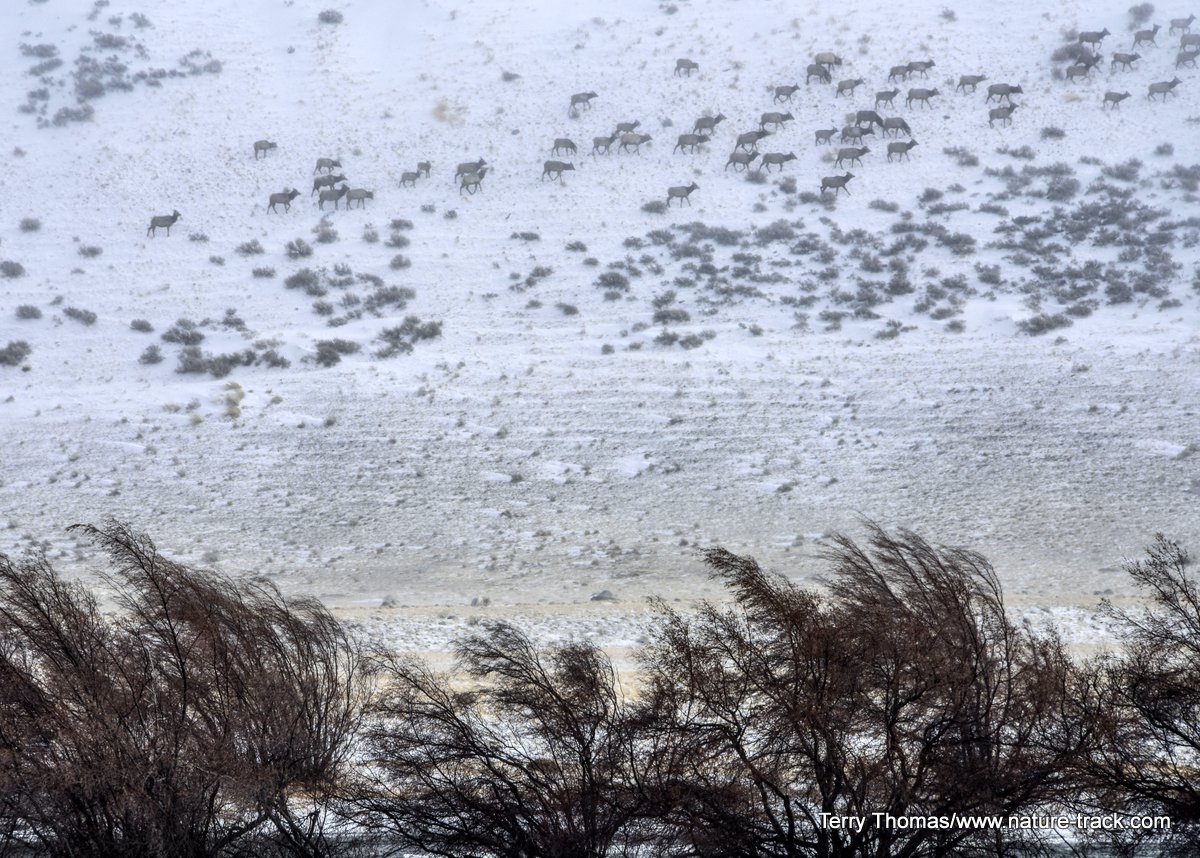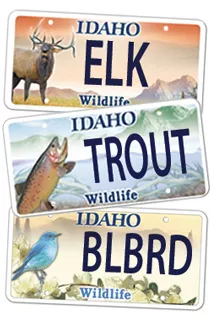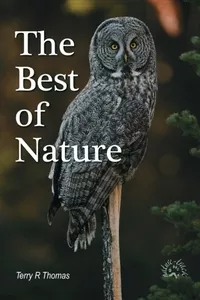Wind Chill

Wind can significantly increase the impact of cold temperatures so these elk sought shelter on the lee side of the wind whipping off the Madison Range near Ennis, Montana on January 1st, 2022.
On January 1st, temperatures in Island Park dropped as low as -15 degrees Fahrenheit. That is bitter cold, I don’t care who you are. Even worse, for a 24-hour period, the effective temperature was expected to be as cold as -45 degrees F., cold enough to be deadly because of steady winds.
This phenomenon of having our world actually colder than what the thermometer says is called the wind chill factor. It takes into consideration not just the ambient temperature but how quickly wind can steal heat from our bodies.
Wind chill calculations had their origin in Antarctica during the 1940s. Researchers, apparently bored with their assigned tasks, decided to determine how wind affected the freezing of water bottles. It was long known that wind could shorten freezing time by removing the warm air surrounding objects and they set out to quantify this. After some crude experiments, they developed a rough chart that they dubbed, the wind chill factor. Other scientists found this useful, but average folks couldn’t apply it. Then, in the 1960s, military researchers changed how we think of wind. They tied ambient temperature and wind chill together by giving a new temperature that accounted for the effects of the wind.
The concept of wind chill took off from this point and within a decade was a standard in weather reporting. It was a very specific measurement of how quickly frostbite might occur. For instance, if the ambient temperature was 28 degrees F. and the wind chill factor corrected the temperature to 22 degrees F., you would develop frostbite as quickly as you would at 22 degrees F. and no wind. More specifically, this was for bare facial skin in a consistent head wind—very precise and very narrow in application, but broadly interpreted.
The formula was revised with more testing in 2001, this time on real human subjects and with sophisticated heat loss models for the human body, not water bottles, but even then, the sample size was small. This is the current system in use today and only applies when temperatures are below 50 degrees F. and wind exceeds three miles per hour. It is much less sensitive to the effects of wind than the previous model, but even the researchers who developed it believe it to be, “an imperfect gauge to what it feels like to be outside”.
The National Weather Service continues to promote wind chill precisely because it is a “worst case” scenario and tends to get people to take the possibility of frostbite seriously. However, many climate specialists believe that the wind chill factor should be scrapped as there are better models that measure “feels like” temperatures. These models take into consideration other climatic factors, most notably, humidity and solar radiation, which can dramatically influence perceived temperature even without wind. One of these is called the Universal Thermal Climate Index (UTCI). Several weather channels have also developed their own proprietary “feels like” metrics. However, humans are very different from individual to individual and what feels cold to me may be different to you, making even these “better” models less than perfect.
Near Ennis, Montana on January 2nd, the wind was whipping at about 20 mph, blowing enough snow across the road to obscure oncoming traffic. The outside temperature was 15 degrees F. Combined, the temperature, adjusted for wind chill was -2 degrees F., dang cold, dang blustery, and dang unpleasant. Was it -2 degrees F. on my face? I don’t know, but I do know that it was far colder than it was when we returned home to 10 degrees F. with no wind. I think I will look more closely at the “feels like” indices in the future, but since I essentially grew up with the wind chill index, it still makes some sense to me.

Help Idaho Wildlife
When we traveled across the state in October 2017, most of the vehicles we saw using the wildlife management areas did not have wildlife plates. Buying wildlife plates is a great way for non-hunters and hunters alike to support wildlife-based recreation like birding.
C'mon folks, let's help Idaho's wildlife by proudly buying and displaying a wildlife license plate on each of our vehicles!
See below for information on Idaho plates. Most states have wildlife plates so if you live outside Idaho, check with your state's wildlife department or vehicle licensing division for availability of state wildlife plates where you live.
And tell them that you heard about it from Nature-track.com!
Wildlife License Plates
Great news! as of 2024, there are three NEW designs for license plates. They still are bluebird, cutthroat trout and elk, but they are beautiful.
Idaho Wildlife license plates provide essential funding that benefits the great diversity of native plants and wildlife that are not hunted, fished or trapped—over 10,000 species or 98% of Idaho’s species diversity. Game species that share the same habitats (such as elk, deer, antelope, sage-grouse, salmon, trout) also benefit from these specialty plates.
No state tax dollars are provided for wildlife diversity, conservation education and recreation programs. Neither are any revenues from the sale of hunting or fishing licenses spent on nongame species. Instead, these species depend on direct donations, federal grants, fundraising initiatives—and the Idaho Wildlife license plates.
Both my vehicles have Bluebird Plates. I prefer the bluebird because the nongame program gets 70 percent of the money from bluebird plates, but only 60 percent of the money from elk and trout plates - 10 percent of the money from elk plates supports wildlife disease monitoring and testing programs (to benefit the livestock industry) and 10 percent from cutthroat plates supports non-motorized boat access.
Incidentally, in 2014, the Idaho Legislature denied the Department of Fish and Game the ability to add new plates or even to change the name of the elk and cutthroat plates (very specific) to wildlife and fish plates, a move that would have allowed for changing images occasionally and generating more revenue. It would seem that they believe that we Idahoans don't want a well funded wildlife program.
I think it is time we let the Legislature know that Idahoan support wildlife funding and that we would like to see these generic plates come to fruition.

"WOW. What a phenomenal piece you wrote. You are amazing." Jennifer Jackson
That is embarrassing, but actually a fairly typical response to my nature essays. Since The Best of Nature is created from the very best of 16 years of these nature essays published weekly in the Idaho Falls Post Register (online readership 70,000), it is a fine read. It covers a wide variety of topics including humorous glimpses of nature, philosophy, natural history, and conservation. Readers praise the style, breadth of subject matter and my ability to communicate complex and emotional topics in a relaxed and understandable manner.
Everyone can find something to love in this book. From teenagers to octogenarians, from the coffee shop to the school room, these nature essays are widely read and enjoyed.
Some of the essays here are my personal favorites, others seemed to strike a chord with readers. Most have an important message or lesson that will resonate with you. They are written with a goal to simultaneously entertain and educate about the wonderful workings of nature. Some will make you laugh out loud and others will bring a tear to the eye and warm your heart.
Readers Write:
"You hit a home run with your article on, Big Questions in Nature. It should be required reading for everyone who has lost touch with nature...great job!" Joe Chapman
"We enjoyed your column, Bloom Where Planted. Some of the best writing yet. The Post Register is fortunate to have your weekly columns." Lou Griffin.
To read more and to order a copy, click here or get the Kindle version
Copies are also available at:
Post Register
Island Park Builders Supply (upstairs)
Barnes and Noble in Idaho Falls
Harriman State Park, Island Park
Museum of Idaho
Valley Books, Jackson Wyoming
Avocet Corner Bookstore, Bear River National Wildlife Refuge, Brigham City, Utah
Craters of the Moon National Monument Bookstore, Arco, Idaho